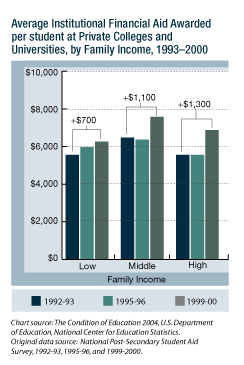Colleges Giving More Financial Aid to Wealthy Students
Blog Post
Feb. 7, 2006
Every year, college gets more expensive. But while policymakers often focus on Pell grants and student loans, another important form of student financial assistance has received less scrutiny—aid provided directly by individual colleges and universities. Traditionally, these grants were based primarily on students' financial need. But in recent years, many colleges and universities—particularly private institutions—have been giving more and more aid to their wealthiest undergraduates, students who wouldn't qualify for aid under most need-based formulas. Why? Because even after taking into account the cost of the aid, these students still provide institutions with far more net revenue than their low-income peers.
According to the National Postsecondary Student Aid Survey, private institutions gave financial aid to about half—53 percent—of students in the lowest income quartile in 1993. That number has held steady, rising only 3 percentage points to 56 percent in 2000. But for students in the highest quartile, the percent receiving aid jumped by 16percentage points, from 35 percent to 51 percent.

Moreover, theamount of money received by high-income students rose faster as well. In 1992, low- and high-income students received the same average award, roughly $5,500. But by 2000, awards jumped by $1,300 for students in the highest income quartile, compared to only $700 for students in the lowest. Public institutions are going the same way, with the biggest increases awarded to the wealthiest students, although the trend is less pronounced than in the private sector.

There's a ruthless bottom-line logic driving this trend: poor students bring in far less net revenue than rich ones, and do nothing to burnish an institution's status in the higher education marketplace. Using sophisticated pricing models originally developed by the airline industry and sold by for-profit “enrollment management” consultants, a growing number of institutions have figured out how to shore up their balance sheet and raise their status in the influential U.S. News rankings by using aid dollars to entice wealthy students who ultimately pay more to attend. More recent data suggest that the trend isn't letting up—the amount of so-called “merit” aid awarded to students increased five-fold from 1994 to 2004, more than four times the rate of increase for need-based aid.[1]
Shifting the student aid focus away from low-income students puts them at risk of being pushed out of elite institutions and out of the four-year higher education sector as a whole. Higher education, long an engine of social mobility, runs the danger of widening our already-growing class divisions instead of narrowing them.
[1] Alan Finder, “Aid Lets Smaller Colleges Ask, Why Pay for Ivy League Retail,” The New York Times, January 1, 2006.
This work by Education Sector is licensed under a Creative Commons Attribution - Noncommercial 3.0 United States License.
Education Sector encourages the free use, reproduction, and distribution of our ideas, perspectives, and analysis. Our Creative Commons licensing allows for the noncommercial use of all Education Sector authored or commissioned materials featured on this site. We require attribution for all use. Link to and credit Education Sector as the original publisher of the work and, if applicable, also credit a particular author.